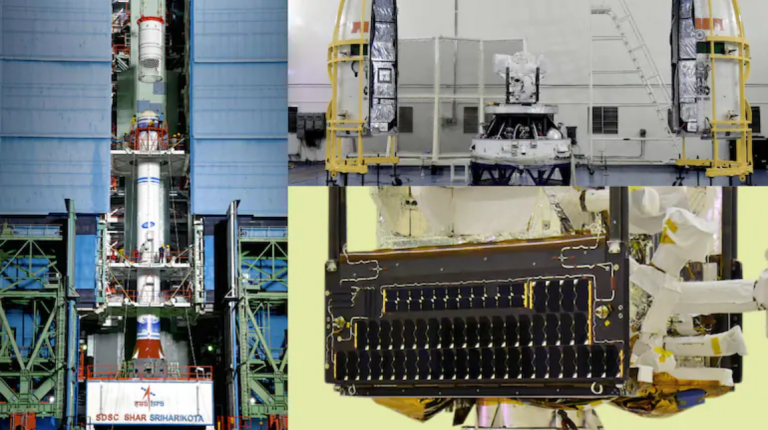The Indian space agency, Indian Space Research Organisation (ISRO) has again added a feather to its cap with the successful launch of Earth Observation Satellite EOS-08. The satellite was launched on the SSLV-D3, the third and final developmental flight of the Small Satellite Launch Vehicle from the Satish Dhawan Space Centre at Sriharikota.
NewSpace India Ltd.
NewSpace India Limited (NSIL) is a NewSpace Company which is an original equipment manufacturer, for the Indian Government, NSIL is a government of India undertaking incorporated on March 6, 2019, under the Companies Act 2013. This organization is under DOS administrative control, which is the commercial arm of the Indian Space Research Organisation (ISRO). As a nodal agency, it manages to undertake PSLV (Polar Satellite Launch Vehicle) production through the Indian Industry adopted on the consortium model. The industry consortium organization is only involved in the manufacturing, integration, and assembly of the launch vehicle for the PSLV.
To serve the new global market of small satellite launch services, ISRO has taken up the challenge of developing the Small Satellite Launch Vehicle (SSLV). NSIL partners with the Indian industry to build SSLV. Since as early as 1999, ISRO has been extending the opportunity to launch customer satellites on PSLV. As of June 2019, PSLV has successfully launched 297 customer satellites from 33 different countries.
NSIL offers transponder lease facilities in C, Ku, Ka, and S bands on INSAT/GSAT satellites to Indian users for the operational requirements of various SATCOM-based broadcasting and telecom applications. Also, in its operation and business, NSIL provides users worldwide with remote sensing services and mission support services. Working in collaboration with ISRO, NSIL wants to establish the necessary environment in India for designing and manufacturing satellites, systems, sub-systems, and grounds support facilities.
It is responsible for the promotion and commercialization of products from the Indian Space Programme to the market. As a public-sector undertaking, NSIL serves as an interface between ISRO’s technology and potential markets, expanding the Indian space sector and providing satellite services worldwide.
SSLV-D3-EOS-08 mission
SSLV-D3-EOS-08 is the third successful launch of ISRO in 2024; PSLV-C58/XpoSat launched in January and GSLV-F14/INSAT-3DS in February. The SSLV rocket weighs roughly 34 meters in length and is capable of launching payloads of up to 500 kg to the LEO or Low Earth Orbit of up to 500 km above the Earth’s surface. The mission is to design and fabricate the microsatellite, develop payload instruments for the microsatellite bus, and demonstrate new technologies for future operational spacecraft.
Three Payloads
The EOS-08 is launched on the Microsat/IMS-1 bus and has three payloads onboard. The Electro-Optical Infrared Payload (EOIR) produces images in the Mid-Wave IR (MIR) and the Long-Wave IR (LWIR) during the day and at night. We find its uses in satellite remote sensing, disaster management, and environmental monitoring. Based on the results obtained from GNSS-R, the GNSS-R payload of the European Envisat/ASI satellite known as the Global Navigation Satellite System Reflectometry demonstrates the usage of the GNSS-R remote sensing technique for the estimation of ocean surface wind, soil moisture, as well as flooding situations. SiC UV Dosimeter is used to determine people’s exposure to ultraviolet radiation. The spacecraft’s mission duration is one year, with the total mass of the craft being about 175 kilograms. 5 kg and delivers approximately 420 watts of power.
Significance of EOS-08
Using data obtained from EOS-08, images are obtained and enhanced both in the Mid-Wave IR (MIR) and Long-Wave IR (LWIR). These images are beneficial in several areas, including security surveillance, disaster management, and global monitoring. The satellite also plays host to a Global Navigation Satellite System-Reflectometry Payload (GNSS-R). Based on GNSS-R applications, the assessment of ocean surface wind, soil moisture content, and flood can be estimated through remote sensing.
Conclusion
The successful SSLV-D3-EOS-08 mission provides NewSpace India Ltd with better opportunities for consecutive commercial launches of Small Satellite Launch Vehicles. This helps India to increase its share in the commercial market for satellite launch services. Having boosted the capacity as well as capabilities in the Earth observation system with EOS-08, India fortifies its stance in space science and research.

Note: You can reach us at support@scoopearth.com with any further queries.
Linkedin Page : https://www.linkedin.com/company/scoopearth-com/













